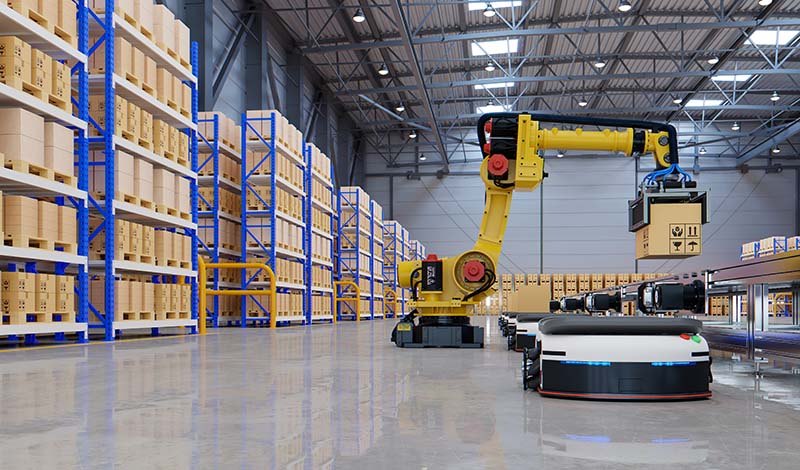
Automated reporting can revolutionize the way you run your inventory and your business as a whole. But what are the specific advantages of automated inventory reporting, and how does this work in practice?
Read on to discover more, or reach out to our team today. Our custom inventory reporting solutions are tailored to your needs. So schedule your consultation today and let’s discuss what we can do for you.
Automated inventory reporting essentially takes a key business process and updates it for the digital age. This means utilizing real-time data to issue a comprehensive report via automated tools. Your inventory and product data are captured on an up-to-the-minute basis. These form the foundation for a highly accurate report.
You can even take this automation a step further. Teams can set their inventory management solutions to commission reports automatically when certain conditions are met. This includes when a specific point in time is reached or if there is an abnormal fluctuation in inventory levels.
It is also possible to execute automated inventory controls based on this data. This creates an overarching system of reliable inventory reporting and data-backed action – even across multiple locations.
What are the advantages of automated inventory reporting? Let’s explore some key benefits to your business and operations.
1
Inventory tracking is critical to the strategic decisions your business makes. You need to know precisely how much inventory you currently have in your warehousing space. You must identify when to step up production to replenish this inventory when levels begin to fall.
If you are looking to improve the agility of your production infrastructure, updating it may be necessary. One area that could benefit from automation is inventory management. Manual tracking of products and purchase orders can be time-consuming and prone to errors.
By implementing reports on automated inventory products, you can gain a better understanding of what steps to take to streamline and optimize your inventory management.
With accurate and real-time reporting, you can make informed decisions and quickly adjust your production output as needed. This can ultimately lead to cost savings and increased efficiency in your business operations.
But what about longer-term strategic decision-making? Automated inventory tracking helps with this too. For example, you may need to switch suppliers or grow your partner network to meet customer demand.
On the other hand, you may need to update your production infrastructure to achieve better agility. Automated reporting can help you understand what steps to take.
2
Keeping on top of inventory levels has traditionally been a complicated exercise. Inventory data needs to be checked and re-checked. Reporting delays can lead to problems as fluctuating levels are not reflected in the latest data.
Automated inventory management systems have revolutionized these processes, making life much easier for business owners of all types. This is true for small businesses to large-scale enterprises.
These solutions report on your automated inventory management processes in real-time, delivering product and component data without delay. This, in turn, makes close control much easier. Your teams gain an accurate and evolving picture of your inventory at the present moment. From start to finish, the inventory control process is simplified and optimized.
3
Inventory management and control require high levels of accuracy and precision. This is very difficult to achieve with manual processes. Human teams are adept at creative and critical thinking tasks but not the repetitive tasks associated with inventory management.
Handling these tasks manually increases the risk of human error. Automated reporting eliminates this risk, and your teams can be redeployed to jobs better suited to their particular skill sets.
4
Automating your inventory management processes saves time and resources, leading to significant improvements in performance. The whole procedure is streamlined, so wastage and delay are minimized.
This is critical in the modern business environment. Slow and cumbersome processes, and resource-intensive tasks, make businesses inefficient and ineffective. By implementing these solutions, your organization becomes more flexible, more agile, and better positioned to achieve a competitive advantage in the market.
5
Deploying real-time inventory tracking and reporting reduces the costs associated with running your business, resulting in increased profitability. The longer your products are left idle in your warehouses, the greater the risk of wastage and shrinkage. This damages your business’ bottom line. Automated solutions give your business the confidence to implement more efficient production concepts, like just-in-time fulfillment, protecting your revenue.
Automation also helps to optimize your position within the supply chain. You’ll know exactly when to order new materials to step up production and when to shift your focus from one product to another according to customer demand. By drawing upon data from the point of sale and from the reorder point, software solutions provide a comprehensive understanding of statuses across the supply chain and how this impacts your inventory.
6
Customer demand changes over time, and your business needs to know how to respond. By integrating with sales data, automated solutions offer insight into customer trends and tastes and how these trends and tastes are changing. From here, you can ensure your inventory and sales channels are ready to fulfill customer expectations in the short- and medium-term.
Success depends on accurate data and swift action. Automated inventory management makes both these things possible, helping your teams feel confident in the data they are working with and empowering them to take action without delay when required — whether this means launching a new product or replenishing levels of existing stock.

The best way to manage inventory with an automated system in practice depends on the structure of your business. These solutions need to be tailored to match the company’s specific requirements, so each system will be a little different. However, a few general tenets of inventory automation will be present in most systems. These include:
1
Reporting via your automated inventory management software requires real-time product data. The solution tracks inventory counts and stock level continuously, giving your business a clear picture of these levels and what actions your teams need to take to optimize them.
2
Real-time tracking is supported by up-to-the-minute reporting. When reports are commissioned, they draw upon the data that exists at that present moment — there is no lag or delay, and the reports are 100% accurate every time.
3
The software draws upon data from various sources, including the hardware solutions deployed within your warehouses. These material handling solutions can provide valuable information about warehouse operations and performance. These solutions will also be used to execute changes within the warehouse itself, making automated inventory control much more straightforward.
4
Inventory management systems are part of your broader software ecosystem. This means the solution will need to integrate with other pieces of software, sharing data to achieve comprehensive insight in real-time.
When you want to move away from manual inventory tracking processes towards something more reliable, you need the right set of automated solutions. Here at PEC, we take pride in delivering tailored solutions to our clients, working with them to understand their needs, and then building systems that meet these requirements perfectly. It all begins with a consultation — so reach out today, and let’s discuss the specifics of your inventory automation project.